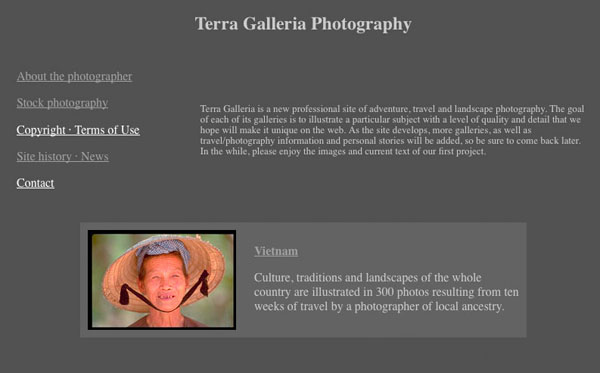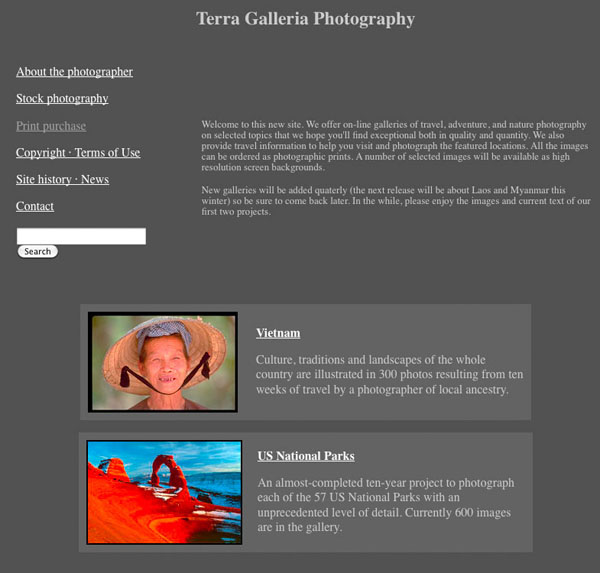Ten Years Ago – terragalleria.com
9 Comments
Ten years ago, in April 2001, I launched terragalleria.com. It wasn’t until 2002 that I became serious about turning the website into a business. Although I had high hopes then, little did I know that it would take me to where I am now.
In this post, I’ll reflect on where I was ten years ago. In following posts, I will look at the road traveled, detail what I didn’t do, and what I did to get there. Maybe the series will be interesting for those who seek to follow my path from a amateur to a full-time photographer. Some of this information was in an interview, part of John Lund’s great series of conversations with people of interest in stock photography, but I’ll go into more depth here.
In 2001, Canon launched its first professional-grade digital camera, the EOS 1D, which provided 4MP for $5,000. Despite their fragility, the best memory cards available were IBM Microdrives, since offered 1GB for less than $1,000. This was considerably more space than solid-state flash media, and also a much better space per dollar ratio. Of much more practical interest for me was the release of the Nikon Coolscan LS-4000 ED, the first affordable scanner offering 4000dpi and ICE dust/scratch removal. However, I didn’t have the scanner yet at the time I launched terragalleria.com, relying on Kodak PhotoCD scans – a format that now requires a plug-in to read into Photoshop.
In 2001, Apple released the first version of Mac OS X (which compelled me to switch to the platform, as it was UNIX-based). My Powermac “QuickSilver”, came with a 466Mhz processor, 128MB RAM, and a 30GB HDD. Photoshop was at version 6 (CS5 is 12). Suffices it to say that the scanned 110MB 16bit TIF files were painfully slow to process and archive. Six of those files would fill up a CD. There were no DVD writers.
In 2001, Flickr had yet to exist (it would launch in 2004). Istockphoto was founded the previous year, but initially distributed images for free. In 2001, it began to charge the licensing fees now known as “microstock”.
I had been shooting with a DSLR camera since 1985, and a large format camera since 1993. In the 90s, I had exposed thousands of 5×7 transparencies, including many for which I am still proud, yet up to that point I considered myself strictly an amateur photographer. In 2001, I was employed as a researcher in the Artificial Intelligence Center (AIC) of SRI International in Menlo Park. Here is my SRI web page, unchanged from the day I would leave the Institute, years latter. At SRI, I had plenty of time for photography, taking up to a few months of leave without pay per year, yet my salary was plenty to fund my travels and equipment. Prior to 2001, I had no needs nor plans to make money from photographs.
Sure, in the late 90s, my mountaineering images had appeared in various specialized magazines, but the thrill back then was more in climbing the routes and getting published than anything else. For instance, when Climbing Magazine published on a double spread my picture of the summit ridge of Mt McKinley (incidentally taken with a P&S Camera, the Yashica T4), it was the memento of being there and creating that image in difficult conditions which brought the most satisfaction. To submit images, you had to label meticulously slides (by writing or printing on the mount), stuff them into slide pages, and send them around, hoping that they wouldn’t get lost or damaged in the process. When your images would come back, weeks, or most often months later, you’d have to refile them carefully in your folders. It’s not something that you wanted to do by yourself on any large scale.
I had also sold prints to friends and to the Institute, but there again the thrill was above all in seeing the images well printed – which wasn’t that easy. In 2001, there was no large format photo-quality archival inkjet printing. The Epson RC dye prints looked reasonably good, but although they were advertised to last about ten years, I had found that to be more like ten months, in the case of sensibility to ozone. The alternative was to use third party pigment inks, but they would work only on matte papers and produce quite flat-looking prints. So there were only two digital printers of choice the Lightjet, and the Durst. Digital printing as a whole was a relatively new choice (to which I was introduced to by Mark Dubovoy): in the 90s, my prints were made on Ilfochrome using contrast masks and optical enlargers. There were no printing services (online or not) catering to consumers, all of the labs were geared towards commercial printing. Only a few had Lightjets (it is a $150,000+ machine that takes up a room). Since I did not have the required printmaking expertise – I knew enough about color management, sharpening, etc.. to understand that I wouldn’t do a good job – I would send out transparencies to the lab and let them do everything: scanning, digital work, and printing. I would charge my “clients” just enough to have two prints made, one for them, and one for myself to keep, which was actually quite a bit. At that time the cost of the process was such that I couldn’t justify having images printed if they were just for myself.
In the fall of 2001, I got married. I anticipated that this would soon change the free time and resources that I had available. I had also began to understand the potential for exposure that a website offered. It is thanks to my own mountaineering web page and a two-year old search engine popular with academics (with the odd name of Google) that I met my wife.
So far, I had been hosting my website on the SRI server. It consisted of two elements: mountaineering, and large format photography. However, the AIC webmaster had hinted to me that maybe it wasn’t entirely proper that my personal traffic would sometimes dwarf the AIC’s professional traffic. It was time to move to my own website. I chose this long and difficult-to-spell name because as a then-Frenchman of Vietnamese origin, living in California, I did not want the name to be tied to any particular modern language. I also thought that the Latin name was poetic and reflected my goals in photography to celebrate and share the beauty of the world. You can see the three first incarnations of the terragalleria.com site, as it existed in 2001 on the screen shots below, and if you are curious, we can even browse those pages on the wayback machine to see how much has changed, and how much has remained the same.
terragalleria.com started as an experiment. The goal was to see how far a photography website could take me, in the absence of any other activity than my own photography and web publishing. We’ll look at that in the next installment, and I’ll share with you some numbers which are usually quite guarded.



Part 1 of 6: 1 | 2 | 3 | 4 | 5 | 6


Excellent background on how you got started. I look forward to reading more!
Patrick
Interesting background QT. Looking forward to reading the rest of your story.
Hi Tuan: You had the world’s first DSLR if you’ve been shooting with one since 1985 🙂
In reading your post, I too am reminded of how much photography and printing have changed in only ten years!
FWIW, I’ve been following you for a long time because of my own climbing background. It was always a pleasure looking at your well-made climbing images.
I wish you the very best in your next ten years! BTW, the Fotopedia Parks app is beautiful!
I’m loving this series. Without your website, I wouldn’t know the beauty of America (and the world) and wouldn’t enjoy photography. As an international student coming to US 4 years ago, terragalleria helped me experience the best of America indeed. Thank you and looking forward to the rest.
Hi QT,
Congratulations on such an exciting and successful 10 years! I am really looking forward to reading more details about how your path lead you to where you are now.
Anne.
Great write-up QT. I’ve been following your climbing career for some time as a climber myself, and your images are simply stunning.
Dude,
As someone who has been following you for over ten years I have been very inspired by you. Your large format forum pushed me to up my game big time. I am still very much an amateur trapped in the corporate side of silicon valley. This post really drives home your level of commitment. Something else I need to emulate. It is great to see how much progress you have made. Well deserved.
Many Thanks, Dave.
It’s funny how long it’s been and how fast it’s gone. I wasn’t sure if I was surprised by how long ago or how recent your wedding was!
QT,
I originally stumbled on your site because I bought a Horseman 4×5 field camera from a friend and was seeking some info on how to work the thing. I had been shooting with a Rollei 35s since 1977 along with a series of 35mm and digital cameras. Your site was just the right mix of technical info and just plain great pictures of all the places I wanted to go. I work for a printer and ran a Crosfield drum scanner for years. It is now neglected as an unnecessary piece of equipment that sits in the corner powered down with no chance to scan my 4×5 trannies anymore. Very Sad. I do my best to get out and shoot mostly in the Death Valley area and the Eastern Sierra Nevada but I am in awe of your dedication to the art of photography and travel. Thanks so much for your site as it continues to inspire me. It is a beautiful thing. Sincerely, Gary A.